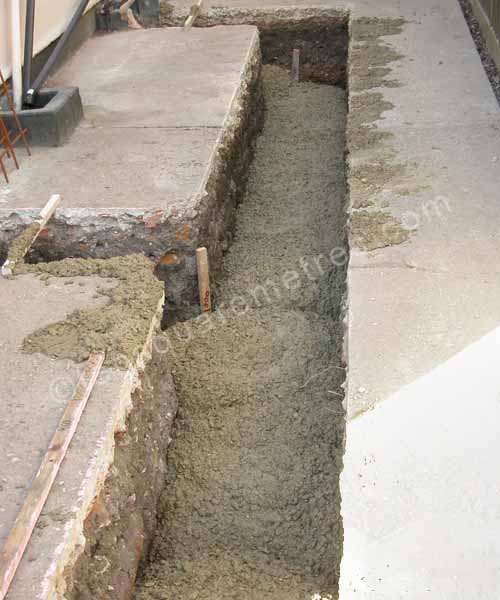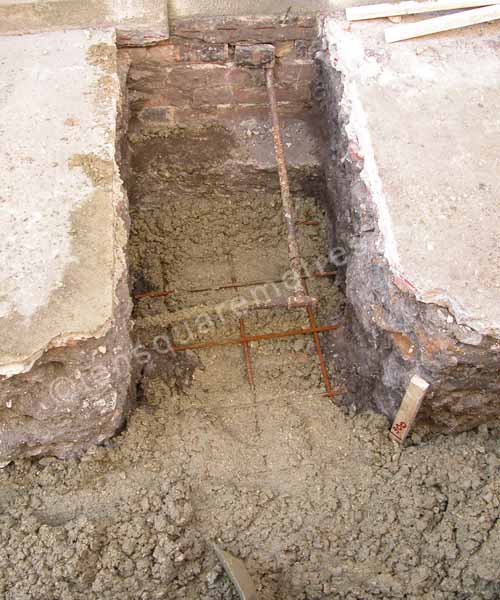GROUNDWORK: concrete foundations
Once I had dug down to the required depth it was time to call Building Control and arrange my first inspection. Foundations are fairly clear cut. The width is listed in the regs and the subsoil dictates the depth. If you dig deep enough there isn't really much you can get wrong and after a brief discussion about drains and reinforcing mesh I was cleared to start the concreting. Although I had bought a cement mixer for the project I decided to order ready mixed concrete for the foundations. I calculated that I needed 1.91 cubic metres. That's about four tonnes.
 June 2008: Four tonnes of concrete arrive.
June 2008: Four tonnes of concrete arrive.
If you add up the material costs to make it yourself, it actually works out quite good value for ready mixed. It is common practice these days to fill foundation trenches to ground level irrespective of the required thickness. This is purely a cost issue. It is cheaper to pour in concrete than pay someone to lay bricks. For us, labour has been as cheap as it gets so we calculated exactly what we needed for our 300 mm thickness. Our two cubic metres of C20P (Gen 3) was £195 inc VAT.
The deal with mixed concrete varies from supplier to supplier but basically, if the chute won't reach the trench they will wait for half an hour curbside for the delivery. This would mean you could get the concrete shot straight into your barrow. They told me that my load would be about 50 barrows so it would be a pretty busy half hour. Some places will offer a casual deal to barrow it for you or stay an extra half an hour for about £30. You can also get mixed concrete pumped over quite long distances but this starts to get expensive. For our fairly modest foundations I guessed I would be able to barrow most of it in my allotted time. I just laid out a plastic sheet so they could shoot the rest onto the drive at the end.
 June 2008: This was all that was left at the end of my half hour delivery slot.
June 2008: This was all that was left at the end of my half hour delivery slot.
A large builders barrow was another of my early purchases and I would strongly recommend one for anyone attempting this type of project. It has been invaluable for all the earth and rubble moving. On the big concrete day it was essential. Barrowing 4 tonnes of concrete was actually less traumatic than I anticipated and I managed to get the vast majority into my trench in the half hour delivery. I also needed to put the mesh in as I went along. My main worry had been if I hurt my back at the start and was left with a mountain of setting concrete in the drive so I did arrange to have a couple of people on call just in case...
The foundation concrete would have to remain visible until the next Building Control inspection which would be for the floor slab preparation and damp proofing.
 June 2008: The A393 mesh over the middle section of drain. The water main was above the height of the concrete.
June 2008: The A393 mesh over the middle section of drain. The water main was above the height of the concrete.
 June 2008: The trench filled to the 300 mm marks on the wooden stakes.
June 2008: The trench filled to the 300 mm marks on the wooden stakes.
If you have found this website useful please tweet / like / etc... and pass it on!
© 2010- tensquaremetres.com | Privacy | Search | Contact | About